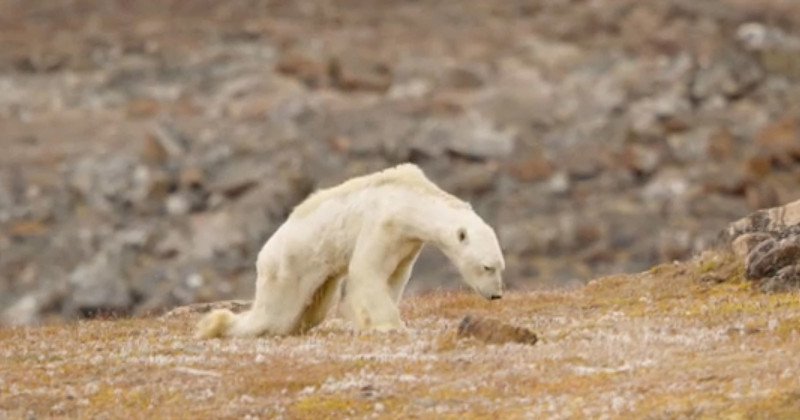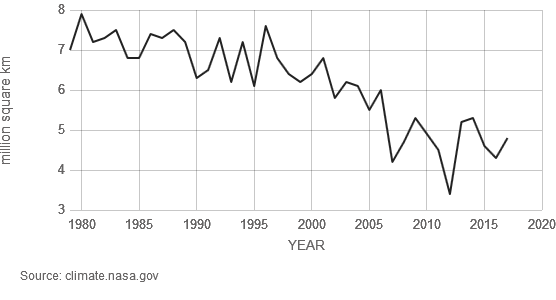National Geographic photographer Paul Nicklen photographed this starving polar bear on Canada’s Somerset Island. Polar bears need ice pack to hunt and survive. The length of the ice pack hunting season has dropped dramatically over the last 25 years and polar bears are starving during the ever longer “fasting season” when there is no ice pack. Video of this bear follows.
I heard an interview with Paul Nicklen on NPR (part of the interview is below). In his long career photographing the Arctic, he is seeing starving polar bears in a way he didn’t see 20 years ago. It is heart breaking. Before the recent warming of our climate, polar bears put on enough weight during the ice pack hunting season to survive the season without ice pack. The ice pack season is getting shorter and shorter and the polar bears are hitting the point they can’t survive the long ice pack free season.
As the ice pack recedes each summer, the polar bears wait on land for the ice pack to return. Due to diminished pack ice at its minimum it is taking longer and longer for the winter ice pack to grow and reach the hungry bears.
“In 2002, a World Wildlife Fund report predicted that climate change could eventually lead to polar bear endangerment or extinction. Even then, the report found that polar bears were moving from ice to land earlier and staying on land longer, unhealthily extending the bears’ fasting season. By the end of summer, most bears studied by the World Wildlife Fund showed signs of starvation. Fifteen years later, polar bears’ icy hunting grounds are in even worse shape. The National Snow and Ice Data Center, which tracks sea ice cover annually, has regularly noted record lows in sea ice coverage—a decline that is expected to only get worse.” National Geographic
Paul Nicklen – NPR Interview
“In the last 20 years, to have the scientists talking about how we’re reaching the lowest extent of ice we’ve ever had, a place like Svalbard, Norway historically has been covered by sea ice year-round. In the last 20 to 30 years that ice has been just in a few fjords, and then now in the last few years there’s been no ice at all around Svalbard. There’s been a little strip down on the east side.
“And when there’s no ice that means bears basically do not have that platform to catch seals, and that’s their main food source. They might eat a little bit of seaweed … they might get the odd bird egg or the odd bird, but that’s not giving them any nutritional value.
“Essentially, bears are designed to go on land for long periods of time. They can be on land for two months and not eat a meal. But they’re not designed to go four or five or six months on land without eating any food, and that’s where we’re starting to find emaciated bears, dead bears. …”
More of this interview here.
Sad to say, as Nicklen and many others have been pointed out, other wildlife in the Arctic is also at risk due to the warming climate.
Watch 25 Years of Diminishing Arctic Sea Ice in 1 Minute.
Links
Heart-Wrenching Video Shows Starving Polar Bear on Iceless Land – at National Geographic
Your Questions About Our Starving Polar Bear Video Answered – at National Geographic
This is the face of climate change – at Sea Legacy
Polar Photographer Shares His View Of A Ferocious But Fragile Ecosystem – at NPR
Arctic Sea Ice News and Analysis – National Snow and Ice Data Center
Arctic Sea Ice Minimum – NASA Satellite Imagery
Arctic Amplification – Earth Observatory


